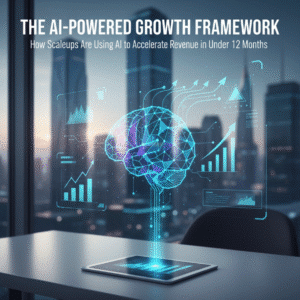
The digital era has changed completely and so is how a business grows by embracing AI in business development. The business landscape has fundamentally shifted because where traditional scaleups once took years to reach significant revenue milestones, companies with AI business growth strategy are now achieving extraordinary growth within few months.
Recent data reveals that enterprise AI startups are hitting median annual recurring revenue (ARR) of $2.1 million by month 12, with top quartile performers reaching an impressive $5.3 million ARR in the same timeframe.
Additionally, a COO at a Bengaluru-based SaaS scaleup told us, “AI didn’t just make us faster; it changed how we sell, serve, and decide.” This isn’t just gradual improvement: it represents a complete transformation in how businesses can scale. The question isn’t whether AI will accelerate your growth, but how quickly you can implement the AI growth framework to capitalize on this unprecedented opportunity with a clear plan, and not just jugaad.
The Three-Pillar AI Growth Framework

The most successful scaleups aren’t spraying AI everywhere and praying. They follow a well-designed AI business growth strategy which lies in three interconnected pillars that compounds across product, revenue, and operations think systems. In plain terms: fewer tools, tighter loops, faster learning.
Pillar 1: Hyper-Personalized Customer Experiences
The foundation of AI-powered growth lies in delivering individualized attention at scale. Leading companies using AI in business development can analyse product usage, intent signals, and support history to customize the experiences from first touch to expansion without making customers feel like they’re talking to a bot.
What does this look like in practice?
- Smart recommendations that surface “next best actions” inside the product
- Proactive nudges when usage dips, preventing churn before it sets in
- Conversational support that resolves common issues in seconds and routes complex ones to the right human
Example: A Bengaluru HR-tech scaleup created user events to feature-affinity models and personalized onboarding by role. In 90 days, activation jumped 18% and logo churn dropped 22%. Not magic just good data, tight feedback loops, and a bit of chai-fueled discipline.
The result: lower churn, faster time-to-value, and product adoption that compounds month after month.
Pillar 2: Intelligent Sales and Marketing Optimization
The second pillar is where AI sales optimization shines as it transforms the revenue engine. AI systems prioritize high intent accounts, orchestrate multichannel outreach, and optimize campaigns in real time so teams focus on conversations, not spreadsheets.
Companies implementing this pillar report remarkable results: 35% more pipeline and 25% higher conversion rates. Not vanity metrics just structural efficiency.
Miniplay book:
- Predictive lead/account scoring tuned to your ICP and past wins
- Auto-generated first drafts for emails, sequences, and ads (humans finetune)
- Meeting intelligence that extracts pain points, competitors, and next steps
- Routing that gets the right lead to the right rep within minutes
Example: A GCC-based cloud reseller used AI to score partner-sourced leads and schedule outreach when stakeholders were most responsive. Meetings per rep rose 1.7x in eight weeks, while reply quality improved because messages referenced live product usage and intent.
Pillar 3: Scalable Operational Efficiency
The third pillar makes growth tidy, not tumultuous. Automation covers forecasting, risk detection, support triage, and reconciliation—so headcount can grow slower than revenue.
Example: A mid-market fintech automated ticket deflection and monthly close. First-response times dropped by 46%, and finance moved from T+12 to T+5 days—without additional hires.
This lean model keeps unit economics healthy. Alos, beyond sales, the AI business growth strategy also streamlines operations, handles the repeatable work; your team tackles strategic moves that truly shift the needle.
The 12-Month Acceleration Timeline

Understanding the typical AI-powered growth trajectory helps set realistic expectations and identify key milestones.
Recall the compounding loop: better personalization → higher retention → more efficient acquisition → richer data → even better personalization. Here’s how with the right AI growth framework, scaleups is typically visible:
Months 1-3: Foundation Phase
Most companies establish similar baselines here typically $100–300K ARR. Enterprise cycles still take time, AI or not. Use this phase to ship fast and learn.
Do this now:
- Stand up data pipelines; define golden metrics (activation, PQLs, time-to-value)
- Launch one revenue pilot (lead scoring or onboarding) with clear success criteria
- Instrument everything; start a weekly “growth stand-up” to review signals
Months 3-6: The Great Divergence
This is where the gap opens. Top quartile performers touch ~$2.0M ARR by month 6; median companies reach ~$700K. The leaders tighten ICP, sharpen value, and let AI amplify what already works.
To accelerate:
- Upgrade your scoring models with win/loss data; prune low-fit segments
- Layer conversational intelligence to coach reps and shorten feedback loops
- Expand successful pilots to two adjacent workflows (e.g., renewals, expansions)
If you’re behind, don’t panic fix positioning, simplify the offer, and integrate AI where it directly moves pipeline, not everywhere at once.
Months 6-12: Exponential Scaling
The final stretch showcases compounding in action. Top companies more than double again—from ~$2.0M to ~$5.3M ARR—while median performers triple to ~$2.1M.
Make the flywheel spin faster:
- Automate playbooks for upsell/crosssell; trigger outreach on real usage signals
- Shift budget from broad awareness to high-intent capture and partner motion
- Operationalize forecasting and capacity planning so scale doesn’t strain service
Incredible, right? This is the virtuous cycle you’ve been building toward.
Strategic Implementation Areas That Drive Results

Key focus areas for deploying AI business growth strategy include:
Revenue Process Optimization
Focus initial AI on core revenue motions. Deployed well, teams see ~35% more pipeline and ~25% higher conversion.
Start here:
- Shortlist 2–3 candidate workflows (lead routing, onboarding emails, renewal alerts)
- Score them by impact, data readiness, and integration complexity
- Pilot one workflow per team; define owners, SLAs, and review cadences
Why it works: AI spots patterns in winning engagements, adapts messaging by segment, and keeps follow-ups impeccably consistent key to keeping your sales staff motivated.
Sales Cycle Acceleration
Process automation and intelligent workflows often cut sales cycles by ~30 days. Faster cycles don’t just speed revenue recognition, but they let teams close more within the same quarter.
Think about:
- Identifying stage-level bottlenecks and instrumenting “next best action”
- Auto drafting proposals and MSAs; pushing approvals through with nudges
- Centralizing deal notes so handoffs are smooth, and context isn’t lost
Result: a more efficient, predictable revenue engine that feels lighter to run.
Customer Value Expansion
Personalization can lift customer lifetime value by up to ~40% when experiences evolve with needs. Expansion usually starts with one team or use case, then spreads.
Play the long game:
- Map usage to ROI; surface value moments in QBRs with simple visuals
- Trigger expansion offers when adjacent features hit readiness thresholds
- Equip CSMs with “what to recommend next” based on cohort outcomes
The key: systems that learn continuously and trigger timely, relevant outreach.
Implementation Roadmap for Maximum Impact
Getting started requires a structured approach that minimizes risk while maximizing learning opportunities.
Phase 1: Assessment and Strategy Alignment
Begin with a comprehensive assessment of current revenue processes. Identify the highest-impact areas where AI can help immediately and align with business objectives and measurable KPIs (revenue growth, CAC, retention).
Checklist:
- Map processes end-to-end; note data sources, owners, and pain points
- Define ICP and key moments of value; agree on “north star” metrics
- Establish governance: privacy, model monitoring, and human in the loop
Phase 2: Pilot Program Development
Start with small, focused pilots before full deployment. Validate effectiveness, reduce risk, and ensure clean integration.
Pick pilots you can measure in weeks:
- Customer segmentation, lead/account scoring, onboarding personalization
- Define baselines and targets; lock success criteria before launch
- Run A/B tests; review weekly; kill or scale decisively
Phase 3: Scaling and Optimization
Once pilots show ROI, scale what works. Standardize data, document playbooks, and roll out in waves.
Do this to avoid chaos:
- Productize the models (APIs, SLAs, observability) before wider use
- Train teams; define new roles and responsibilities as scope expands
- Keep iterating—ship small improvements every sprint based on live data
Consider how the existing team can adapt to AI augmented workflows, and at what stage you’ll promote pilot owners into platform owners.
The Competitive Advantage Window
The statistics are clear: 61% of companies adopting AI in business development report 10–20% revenue increases, and by 2025, 85% of companies are expected to have AI strategies in place. The early mover window is closing—this bus is leaving the depot.
AI’s superpower for scaleups is fast with visible ROI. Unlike traditional enterprise software that takes months to show value, AI apps often deliver benefits in days or weeks.
Let us look back at the three pillars: personalization improves retention, optimization boosts acquisition efficiency, and automation protects unit economics. Together, they compress decision cycles, enterprise buyers now move in weeks, not quarters.
Your Next Steps
The evidence is overwhelming: AI-powered growth frameworks are transforming how quickly scaleups reach meaningful revenue milestones. Teams that implement now enjoy compounding advantages over those who wait.
Start with a clear-eyed revenue process assessment. Identify where AI can move the needle immediately, then run focused pilots that prove ROI. Aim for learning systems that improve every week—not perfection on day one.
Remember: median AI startups reach ~$2.1M ARR by month 12, and top performers hit ~$5.3M. With the right framework, your scaleup can be in that cohort.
If you’d like a sparring partner, CUSP Services’ advisory team helps scaleups and midmarket firms blueprint and execute this playbook—end to end across ReFine, RevUp, ReCode, ReBuild, ReCharge, and ReWire. A quick conversation can save months of trial and error.
The question isn’t whether AI will transform your business; it’s whether you’ll capitalize while the advantage is still outsized.
We’re here if you need us—drop a note at Grow@www.cusp.services. Until then, happy scaling!
What is an AI-Powered Growth Framework?
It's a structured approach that uses AI to boost customer experience, optimize sales & marketing, and streamline operations—helping businesses accelerate revenue in months, not years.
What results can Indian scaleups expect from this approach?
With smart implementation, ARR can scale from ₹4–5 crore to ₹12–15 crores within 12 months, based on global and Indian benchmarks. Common gains include 35% more pipeline and up to 40% higher customer value.
What’s the first step to implement AI for growth?
Start with a candid assessment of your revenue process, then run pilots in high-impact areas like lead qualification or onboarding. Don’t try to automate everything at once—get quick wins, then scale.
How can CUSP Services help?
CUSP is your go-to advisory partner for growth frameworks, with hands-on expertise in scaling Indian and global businesses. Reach out for an advisory session at Grow@www.cusp.services.



